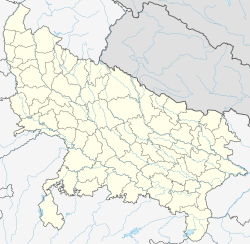world.wikisort.org - India
Kintoor or Kintur is a village in Barabanki district famous for battle of Kintoor of 1858 during the Indian Mutiny.[1][2]
Kintoor | |
|---|---|
Village | |
 Kintoor Location in Uttar Pradesh, India | |
| Coordinates: 27.019°N 81.486°E | |
| Country | |
| State | Uttar Pradesh |
| District | Barabanki |
| Languages | |
| • Official | Hindi, Urdu |
| Time zone | UTC+5:30 (IST) |
| PIN | 225207 |
| Vehicle registration | UP-41 |
Battle of Kintoor
The Battle of Kintoor was a conflict between rebel sepoys and troops East India Company and Kapurthala State on 6 October 1858 during Indian Mutiny.[1][3][4]
British Raj
During 1869 census of Oudh, Kintoor was designated as one of the total thirteen large towns or kasbahs and Inspector of Police of Ram Nagar was appointed here on the night of census.[5]
Personalities
Nishapuri Sada'at of Kintoor
Many of the early Sufi saints that came to North India belonged to Sayyid families. Most of these Sayyid families came from Central Asia and Iran, but some also originate from Yemen, Oman, Iraq and Bahrain. Perhaps the most famous Sufi was Syed Salar Masud, from whom many of the Sayyid families of Awadh claim their descent.[6] Sayyids of Jarwal (Bahraich), Kintoor (Barabanki) and Zaidpur (Barabanki) were wellknown Taluqadars (feudal lords) of Awadh province.[7]
Abaqati family
A branch of the Nishapuri Kintoori Sayeds moved to Lucknow. The most famous of Kintoori Sayeds is Ayatollah Syed Mir Hamid Hussain Musavi, author of work entitled Abaqat al Anwar; the first word in the title of this work provided his descendantswith the nisba (title) they still bear, Abaqati.[8] Syed Ali Nasir Saeed Abaqati Agha Roohi, a Lucknow based cleric is from the family of Nishapuri Kintoori Sayeds and uses title Abaqati.
Literary
Urdu/Persian (19th century)
- Abd ul-Qadir Hanif-ud-Din Kintoori (d. 1789): a Sufi of Qadri order. His ancestors emigrated from Nishapur, Iran, and served as jurists. He was author of the book Kuhl ul-jawahir fi manaqib-i-'Abd ul-Qadir Jilani(1753).[9][10]
- Ayatollah Mufti Syed Muhammad Quli Khan Kintoori (1775-1844): principal Sadr Amin at the British court in Meerut. He was author of Tathir al-mu'minin 'an najasat al-mushrikin.[11][12][13][14]
- Syed Sirāj Ḥusayn Musavi Kintoori (1823-1865): son of Mufti Syed Muhammad Quli Kintoori, he was author of Kashf al-ḥujub wa-l-astār ʿan asmāʾ al-kutub wa-l-asfār, Shudhūr al-ʿiqyān fī tarājim al-aʿyān and Āʾīna-yi ḥaqq-numā.[11]
- Syed Iʿjāz Ḥusayn Musavi Kintoori (1825-1870),
- son of Mufti Syed Muhammad Quli Kintoori[11]
- Ayatollah Syed Mir Hamid Hussain Musavi Kintoori Lakhnavi (1830-1880): son of Mufti Syed Muhammad Quli Kintoori author of book Abaqat ul Anwar fi Imamat al Ai'imma al-Athar.[11][12][8][15][16][17]
- Qazi Mahmud Kintoori author of Mirat i Madari.[18]
Urdu/Persian (20th century)
- Justice Maulvi Syed Karāmat Ḥusayn Musavi Kintoori (1854-1917): son of Syed Sirāj Ḥusayn Musavi Kintoori, he founded Karmat College, Lucknow.[11]
Others
- Seyyed Ahmad Musavi Hindi: Paternal grandfather of Ayatollah Khomeini. He was born in Kintoor.[8][19][20][21]
Attractions

- Parijaat tree a sacred baobab tree on the banks of Ghaghra.[2][22]
- The famous Kunteshwar Temple – dedicated to Lord Shiva.[2][23]
References
- Bulletins and other state intelligence, Part 1
- "Places to visit". barabanki.nic.in. Archived from the original on 22 April 2001.
- House of Commons papers, Volume 43 By Great Britain. Parliament. House of Commons
- Bulletins and Other State Intelligence Compiled and Arranged from the Official Documents Published in the London Gazette
- The report on the census of OUDH, OUDH Government Press, 1869
- People of India Uttar Pradesh Volume XLII Part Three, edited by A Hasan & J C Das
- King Wajid Ali Shah of Awadh, Volume 1 by Mirza Ali Azhar, Royal Book Co., 1982
- Islam, politics, and social movements By Edmund Burke, Ervand Abrahamian, Ira M. Lapidus
- Dictionary Of Indo-Persian Literature, By Nabi Hadi
- Persian Literature: A Bio-Bibliographical Survey : Qur'Anic Literature; History and Biography : Biography Additions and Corrections Indexes, Volume 1, Part 2, by C.A. Storey
- Scholarship in a sayyid family of Avadh I: Musavī Nīshāpūrī of Kintūr
- Roots of North Indian Shi‘ism in Iran and Iraq Religion and State in Awadh, 1722–1859, by J. R. I. Cole, UNIVERSITY OF CALIFORNIA PRESS Berkeley · Los Angeles · Oxford
- Sacred Space and Holy War The Politics, Culture and History of Shi`ite Islam Archived 18 July 2011 at the Wayback Machine by Juan Cole, I.B.Tauris Publishers, LONDON - NEW YORK
- Dar al-Kitab Jazayeri Archived 10 February 2013 at archive.today
- Leader of Heaven Archived 3 January 2010 at the Wayback Machine #18
- Mir Hamid Hussain and his famous piece Abaqat al-anwar
- GHADEER-E-KHUM WHERE THE RELIGION WAS BROUGHT TO PERFECTION By I.H. Najafi, Published By A GROUP OF MUSLIM BROTHERS, NEW ADDRESS P. 0. Box No. 11365- 1545, Tehran – IRAN.
- Persian Literature – A Biobibliographical Survey ..., Volume 1, Part 2 By C. A. Storey
- From Khomein, A biography of the Ayatollah, 14 June 1999, The Iranian
- The Columbia world dictionary of Islamism By Olivier Roy, Antoine Sfeir
- Khomeini: life of the Ayatollah, Volume 1999 By Baqer Moin
- Wickens, Gerald E.; Pat Lowe (2008). The Baobabs: Pachycauls of Africa, Madagascar and Australia. Springer Science+Business Media. p. 61. ISBN 978-1-4020-6430-2.
- Kameshwar, G. (2006). Bend in the Sarayu: a soota chronicle. Rupa & Co. p. 159. ISBN 978-81-291-0942-2.
External links
- http://offerings.nic.in/directory/adminreps/viewGPmapcvills.asp?gpcode=48746&rlbtype=V
- http://ourvillageindia.org/Place.aspx?PID=562564
- http://maps.google.co.uk/maps?ll=27.01504,81.483387&z=12&t=h&hl=en
- https://online.omms.nic.in/ASPNet/citizens/DG/05DVC/CensusStatus.aspx?state=UP&district=13&block=13&reportLevel=3
- The British Empire – Indian Mutiny 1857–58
- Google Books – Battle at Kintoor
- "Indian Mutiny" by Saul David 2002 ISBN 0-14-100554-8
- Shi'a Islam in Colonial India: Religion, Community and Sectarianism By Justin Jones
- Inextlive Editorial Team (4 June 2014). "आयतुल्लाह ख़ुमैनी का बाराबंकी कनेक्शन (Hindi)". Inextlive.com. Retrieved 5 June 2014.
Другой контент может иметь иную лицензию. Перед использованием материалов сайта WikiSort.org внимательно изучите правила лицензирования конкретных элементов наполнения сайта.
WikiSort.org - проект по пересортировке и дополнению контента Википедии